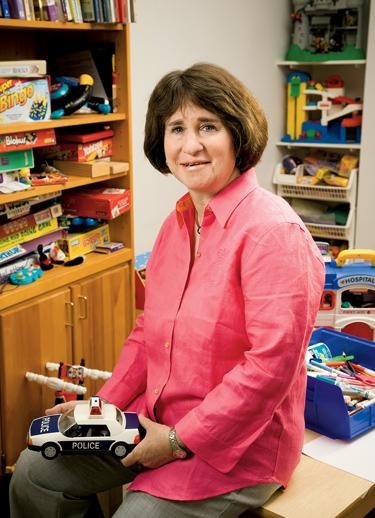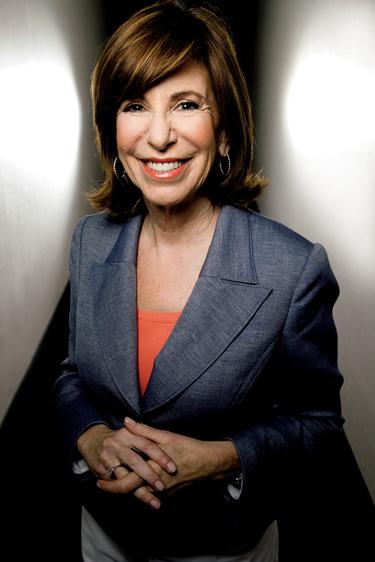Related:
Top Therapists 2009
Getting Back Your Life
How to Tell If a Child’s Anxiety Is Cause for Concern
Do You Control Your Technology? Or Does It Control You?
Stressed? Learn to Recognize Your Triggers and Find Calm
Imagine you’re a young professional attending an interesting lecture. You hear the speaker’s words, but inside your head you also hear something else. It’s like a tape that plays messages over and over or repeats a command—“Read this book” or “Wash behind your ears.” You have difficulty concentrating. You manage to hold it together during the week at work, but on weekends you keep to yourself.
This was Betty.
Now imagine you’re a tense young mother. You’re starving yourself, eating little more than rice and fruit because you believe anything else will make you sick. One evening while bathing your ten-month-old daughter, you step back from the tub and say to yourself, I really don’t care about her. Your husband shows up and you think, I don’t care about him either. You set out on a walk to regroup but start thinking about jumping in front of a car. Instead you go home and ask your husband to take you to the emergency room.
This was Meredith.
Although they’ve never met, Betty and Meredith have a lot in common. Both are smart, accomplished, and well spoken. To most observers, the women seem to lead normal lives. Betty, 39, is an editor. She loves to travel, spend time with friends, and take her dog to the park. Meredith, 38, is a partner in a design firm. She’s a devoted wife and mother of two. Both women live and work in Washington but have asked that their real names not be published. That’s because Meredith and Betty are battling mental illness.
A Long Journey
About one in four American adults suffers from mental illness each year, according to the National Institute of Mental Health. And while some people, like Meredith and Betty, manage to work as they search for help, the journey to well-being almost always exacts a price in terms of relationships, physical and emotional health, income, and time.
It takes an average of eight years for someone to seek treatment for a mental disorder. “The reasons for this include stigma and access to care,” says Mayada Akil, director of the Mood and Anxiety Disorders Program at Georgetown University Hospital and an adviser to the director at the National Institute of Mental Health. “It’s an alarming statistic because you know the disorder is affecting all aspects of their lives.”
Betty suspected something was wrong as early as elementary school but didn’t consider asking for help until college: “I was a psychology major, and I remember taking a course where they gave a checklist for depression. I answered yes to every single question.” Soon after, Betty made an appointment with a university therapist: “When I said out loud that it was as though words were playing over and over inside my head, she said, ‘Of course.’ I felt safe for the first time in my life.”
Both Betty and Meredith have spent years bouncing from doctor to doctor, sampling medicines and therapies, and experiencing setbacks. “I feel like there are pieces of my life that are just a fog,” says Betty, who spent more than a decade seeking an effective treatment. “It’s lost time.”
During the past year, though, each has settled on a treatment that is proving effective—Betty for depression and obsessive-compulsive disorder, Meredith for bipolar disorder. Both women are doing well and, with the help of psychiatrists and therapists, learning to manage their conditions.
What to Watch For
The most common mental illnesses are mood and anxiety disorders. Mood disorders include major depressive disorder; dysthymic disorder, a mild but chronic depression; and bipolar disorder, also known as manic depression. Anxiety disorders include panic disorder, obsessive-compulsive disorder, posttraumatic stress disorder, generalized anxiety disorder, and phobias.
Knowing the signs of mood and anxiety disorders can help. For depression—which affects nearly 15 million American adults a year—symptoms can include trouble sleeping or excessive sleeping; a change in appetite; fatigue; feelings of worthlessness and guilt; extreme difficulty concentrating; agitation, restlessness, or irritability; withdrawal and a lack of interest in activities that were once enjoyable; feelings of hopelessness; and thoughts of death or suicide. Major depression is diagnosed when someone experiences five or more depressive symptoms for at least two weeks.
The same symptoms play a part in bipolar disorder, which causes mood swings that alternate between severe depression at one extreme and mania at the other. The manic phase is characterized by euphoria, inflated self-esteem, poor judgment, rapid speech, racing thoughts, decreased need for sleep, and inability to concentrate.
“You have this bloated sense of self when you’re manic,” says Meredith, who has experienced three bouts of bipolar disorder. In her case, depression and mania either alternate or occur simultaneously. Experts refer to the latter scenario as “mixed state.” Meredith calls it “the worst thing you can imagine.”
“The world makes no sense,” she says. “When you’re manic, there are not enough days to live. When you’re depressed, there are too many. When you put those two things together, it’s a disaster. It’s as though someone has cut off your leg or you have burn pain and can’t get medication—only it’s all in your head.”
Many mood and anxiety disorders occur in pairs. People with depression, for instance, can be diagnosed with panic disorder; generalized anxiety disorder, a condition in which people experience exaggerated worry; or obsessive-compulsive disorder. A person with OCD experiences unreasonable thoughts or fears (obsessions) that can lead to repetitive behaviors (compulsions). Someone who fears being contaminated by germs or dirt might be driven to wash his hands until they become chapped.
“People in these situations—with anxiety and depression—are often very uncomfortable,” Akil says. “All common sense is gone.”

First Steps
The Washington area—home to the National Institute of Mental Health, the American Psychological Association, and the American Psychiatric Association—can be both a good place to find excellent help and a tough place to stare down the stigma associated with mental illness.
“In Washington, the stigma may be worse than it is elsewhere,” says Wendy Hookman, medical director of the Washington Center for Women and Children’s Wellness in Rockville. “It’s probably because a lot of people are involved in government jobs where there is concern about security and drug testing and privacy. We have a very work-focused culture.” Hookman, who completed her psychiatry residency in New York City, says that people there seem more open to talking about therapy.
Carrie Holl, a psychologist who trained in Los Angeles, has noticed a difference between West Coast patients and those she sees at her Dupont Circle practice. “I see more obsessive thinking here,” she says. “I see highly functional people who are still working and who are hiding their symptoms really well, but they are suffering a lot.”
When people do decide to seek help, they typically turn to the Internet—an okay first step as long as they use reputable sources such as the Web sites of the National Institute of Mental Health (nimh.nih.gov) and the Centers for Disease Control and Prevention (cdc.gov).
Eventually, it’s important to undergo an evaluation by a mental-health professional, such as a licensed clinical social worker, psychologist, or psychiatrist. Clinical social workers and psychologists can provide therapy in private practice or in hospitals and other settings but generally cannot prescribe medicine or order medical tests. A psychiatrist is a medical doctor specializing in the treatment of mental illness.
People who are uncomfortable seeing a mental-health specialist or who don’t have access to one should consider talking with their primary-care physician.
“Insist that they take the time to talk to you,” says Akil. Some mood and anxiety disorders can be confused with physical ailments because symptoms can include upset stomach, digestive problems, headache, and fatigue. “I tell medical students that when people are presenting with a somatic complaint you can’t get to the root of, consider a psychiatric problem.” She also notes that certain diseases, such as heart disease and cancer, can be accompanied by depression.
Blood tests can rule out things like thyroid disease, anemia, and Lyme disease and can have symptoms that mimic those of depression. Meanwhile, patients need to talk openly about everything that’s bothering them—and not just physical complaints. “Bring a list,” Akil says, “and stick to it.”
“Calling in the Troops”
Treatment often involves medication. Many antidepressants treat both depression and anxiety. The most popular are selective serotonin reuptake inhibitors, or SSRIs. This group includes Prozac, Celexa, Lexapro, Zoloft, and several others. Serotonin and norepinephrine reuptake inhibitors (SNRIs ) are similar to SSRIs and include Effexor and Cymbalta.
Both SSRIs and SNRIs work to normalize levels of naturally occurring brain chemicals called neurotransmitters. SSRIs and SNRIs are more popular than older classes of antidepressants such as monoamine oxidase inhibitors (MAOIs) and tricyclics because they tend to produce fewer side effects. However, medications affect people in different ways; for some, the older classes of antidepressants are still the best choice. In cases where an antidepressant alone is not enough, drugs such as lithium or thyroid medications can be added.
Antidepressants take two to eight weeks to build up in a person’s system, but side effects such as nausea, headache, or agitation—which are usually temporary—can occur immediately. “If someone is already anxious, this can be a tough time,” Akil says.
When Betty began taking Cymbalta, she felt sick and had trouble eating. “I had to very slowly work up to 60 milligrams,” she recalls. “It didn’t really work until I got to 60. Once it did, I became a different person. It’s the perfect drug for me.”
While waiting for medication to kick in and side effects to diminish, doctors sometimes schedule patients for frequent appointments and emphasize companion treatments such as exercise, a healthy diet, social activity, and family support. Says Akil: “I tell people this is the time to call in the troops.”
Meredith, who takes the anticonvulsants Depakote and Lamictal to regulate her mood, says her husband’s support was critical. He developed a sense for when her mood was dipping toward depression or ratcheting up toward mania.

Talking It Out
Another form of support is talk therapy. Meredith sees a clinical social worker; Betty sees a psychologist.
“I get overwhelmed a lot, so we’re trying to work on how I can look at things differently,” says Betty, who sees her therapist once a week. “We’re discussing my crazy schedule and working to create a framework for looking at life that is mine rather than the one I was trained to see growing up.”
A combination of medication and talk therapy is considered the optimal treatment for mood and anxiety disorders. Cognitive-behavioral therapy and interpersonal therapy are the most popular kinds of talk therapy. Interpersonal therapy focuses on relationship issues, while CBT aims to help people change negative patterns of thinking and behavior.
“CBT is designed to teach people skills they can use even when the treatment is done,” says Holl, who specializes in the treatment.
Psychodynamic therapy, which probes deeply into a patient’s past, is thought to be helpful, too.
“You select the therapy according to what you have before you, what the patient tells you,” says Karen Johnson, a psychiatrist and associate chair of psychiatry at Washington Hospital Center. “People often arrive at these conditions not just because of biological changes but because of developmental issues, so the medication alone may not address the problem.”
In addition to psychiatrists, psychologists, and social workers, psychiatric nurses and licensed counselors administer talk therapy. Fees depend on the location and the therapist’s credentials but typically range from $100 to $200 for a 45-minute session.
Most local therapists—especially those in private practice—don’t accept health insurance. Paying out of pocket is often preferred by patients who worry about who might have access to their health information. Those who can’t afford private therapy might try contacting support groups or clinics run by local universities.
More Treatments
In addition to therapy and medication, electroconvulsive therapy—formerly known as shock therapy—is an option. Today’s ECT is gentler than earlier versions and works by causing a seizure via electrical current. Before each treatment, patients take a muscle relaxant and are put under light anesthesia. The procedure can be administered on either an inpatient or outpatient basis and can cause short-term side effects including confusion and memory loss. ECT is used to treat depression, bipolar disorder, mania, and schizophrenia. Researchers don’t understand exactly how ECT works, but it’s thought that over time the seizures trigger a change in brain chemistry that results in an improved mood.
Another treatment, transcranial magnetic stimulation—approved by the Food and Drug Administration last fall—sends electrical currents through the brain via a magnetic field. Patients recline in what looks like a dentist’s chair; they don’t need sedatives or anesthesia. Side effects of the 40-minute TMS treatment are considered mild, but some doctors question its effectiveness.
“It was hoped that TMS would be a more benign replacement for ECT,” says Daniel Z. Lieberman, director of research at George Washington University Medical Center’s Clinical Psychiatric Research Center. “It will not be, and it may not even be as effective as medicine for mood disorders.”
So far, Sibley Memorial Hospital and Walter Reed Army Medical Center in the District and Sheppard Pratt Health System and Johns Hopkins Hospital in Baltimore offer TMS treatment, as do a handful of doctors in private practice, according to Neuronetics, the manufacturer of NeuroStar TMS Therapy.
Light therapy, which mimics outdoor light and causes a biochemical change in the brain that lifts mood, is an option for patients who experience depressive symptoms during winter months, a condition known as seasonal affective disorder.
Hospitalization may be necessary when a person suffering from depression or another disorder experiences extreme distress or is a risk to himself or others.

Rockville psychiatrist Norman Rosenthal is a top expert on seasonal affective disorder, which about 5 percent of Americans suffer from. Photograph by Matthew Worden.
Solving the Puzzle
No matter what the approach, it takes time to feel better. What works for one person may not work for another.
“With mental illness, sometimes you need more pieces of the puzzle before someone can figure out what’s going on,” Meredith says. She visited eight doctors before receiving a diagnosis of bipolar disorder.
At first, everyone viewed her symptoms too narrowly: “One doctor was interested in my fear of being sick. He thought I had OCD, so he put me on OCD medication. Someone else wanted to look at the depression and put me on an antidepressant. I felt like an idiot. It was sort of like going to a doctor and saying, ‘Look, I’ve got this big thing on my arm,’ and they’d say, ‘It’s nothing.’ You’re like, ‘Really? Because it hurts and it doesn’t feel right.’
“It’s hard to confront doctors,” Meredith says. “They’re educated. They’re writing notes about you. But you have to trust yourself enough to know when the fit is right.”
A former nurse, Meredith found her current psychiatrist through a friend in the medical profession. This doctor spotted the telltale ups and downs of bipolar disorder, wrote a prescription, and assigned a therapist. Things began looking up, but the work isn’t finished.
Thanks to greater public awareness, those experiencing mental illness for the first time may stand a better chance of finding help quickly.
“I’m jealous of people who are having their first depressive episode in this day and age, with the media talking about depression and the fact that there is such a prevalence of information about drugs,” Betty says. “It took me a good ten years from college before somebody handed me a pill.”
These days, Betty and Meredith are focused on figuring out what “normal” looks and feels like. Says Meredith: “With mania, you have no filter, so things you say to people are not things you should say.”
Then there’s the grieving process. This involves letting go of one’s yearning for a mild form of mania, called hypomania, that’s characteristic of early episodes.
“It’s a completely natural high,” Meredith says. “You don’t need any sleep. You feel great about yourself and about the world. You get so much done. You don’t take things personally. It’s truly an ideal way to be except that you’re pretty self-absorbed, so it’s hard to maintain relationships.
“I’ve spent the last two months mourning the idea that if I stay on my medicines I won’t have that again—even though it’s not real.”
And stay on her medicines she must. Bipolar sufferers must remain medicated for life. Likewise, patients who have experienced three or more depressions are thought to need medication indefinitely. Those suffering from their first or second depressive episode may eventually live drug-free, and people with mild depression may be able to recover with talk therapy alone.
A prescription of lifelong treatment can be difficult, especially because many mental illnesses are first diagnosed when patients are in their teens or twenties.
“It’s not consistent with how they see their lives going,” Akil says. “That’s understandable, but unfortunately the medicine is necessary.”
Akil and Hookman stress that mood and anxiety disorders are illnesses with an underlying biological basis. Episodes are triggered either by physiological changes, such as hormone surges associated with pregnancy, or by life events, such as a divorce or death in the family, but they may also arise when there’s no identifiable stressor.
Both Betty and Meredith are coming to terms with the reality of their illnesses.
Says Betty: “I do not anticipate a time when I would be without some type of help, be it a drug or some type of therapy. It’s just like having diabetes or heart disease. I’m going to do what I have to do.”
This article first appeared in the July 2009 issue of The Washingtonian. For more articles from that issue, click here.
















